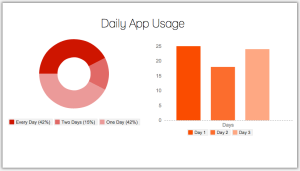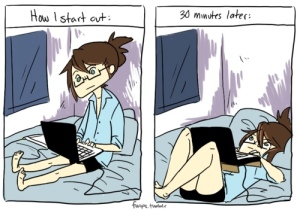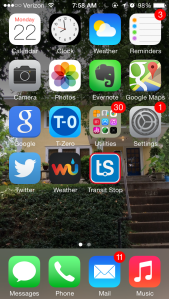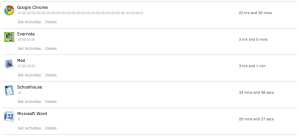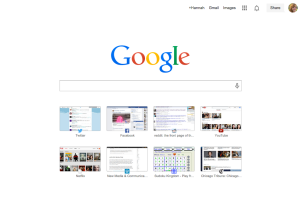My general outlook on new media and technology, both before and after completing this project, is mostly positive. However, I do think my enthusiasm for all things new and shiny has been tempered slightly by my observations over the course of this assignment. Prior to this project, I had never really considered my media usage, aside from recognizing my extreme (perhaps impressive?) procrastination ability. I knew that I often used media to intentionally distract myself from things I ought to have been doing, but I didn’t think much beyond that. This project made me stop and evaluate my media use, taking a closer look at the real effects all these new media have on the way I use technology and interact with the world. Before this assignment, I wholeheartedly believed that all new media was, or had the potential to be, great, especially in regards to smartphone technology. They say there’s an app for everything, and if more is always better, what could go wrong? Throughout this project, my thoughts on that matter have shifted a bit. While I still definitely see the benefits of the ever-changing landscape of new media, I’ve come to recognize the need to prioritize and simplify in my daily life.
My iPhone is a prime example of new media excess. Thanks to the iOS 8 update, I currently have 101 applications on my phone, up from the 97 I had during testing for this project. The fact that I could use a different app each day for more than three months is absurd. Clearly my app collection has been growing for some time, but prior to this assignment I just never thought about it. Sure, a few times I’d tried to reorganize my home screen and briefly marveled at the utility of app folders (of which I used to have almost a dozen), but obviously it wouldn’t go much deeper than that. And I think that’s a major cause of many people’s media use issues today—we just don’t think about it. It’s so easy just to accept the next new thing and then move on without stopping to consider the usefulness or longevity of something.

This chart from Wall St. Cheat Sheet shows that apps take up a considerable chunk of total digital media usage.
I didn’t realize my app collection was so ridiculous until I began recording my field notes for the first part of the project. So while my Camtasia walkthrough and other activity logs also revealed interesting trends in my media use, my phone use struck me as most interesting and potentially concerning. So, to test my app usage more in depth I designated one of three categories for each application: used daily, used at least once a week, and used less than once a month. While I did a pretty good job placing apps in the correct categories, the raw data of which apps I use when doesn’t seem that important to me now. What I’m taking from this project is a new perspective on how and why I use various apps and a clearer idea of the general functionality of new media in my everyday life.
I tend to use the same dozen or so apps each day, most of them with rather basic yet important functions, like an alarm clock, the weather forecast, a calendar, a notebook, and a transit tracker. These are all things I would need or want to use each day, even if it meant some sort of analog version. Beyond these apps, I also use several means of communication throughout the day, from texting to Facebook messenger (although pretty rarely do I use my phone’s actual phone capability, except to call my mom). Aside from these more “essential” apps, I frequently use a few other social media apps like Twitter, Instagram, and Facebook. I use my music or audiobook app each day while commuting, and often during that time I’m also playing my new borderline-obsession, Hay Day, a farming game. Those, plus a miscellaneous app here or there, are what I use each and every day, and I’d consider them all pretty essential in how I get most things done (with the exception of Hay Day—it’s my guilty pleasure).
After observing these seemingly normal usage trends for 72 hours, I had to ask myself about those other 80-some-odd apps. What are they and why do I have them all? Is there a good reason for my excessive app collection? A closer look at which apps fall into the leftover category shows that to a certain extent, there are perfectly good reasons to have so many apps. A lot of them are very convenient in their functionality, but only at specific times or for certain purposes. For example, I have an app, TripIt, which scans your email and compiles all travel information into one place. It’s perfect for when I get to the airport and need to access my confirmation number or flight information. I don’t have to spend 10 minutes scrolling back through my email for the reservation I made weeks ago. While I’m certainly no jet setter, I still feel that keeping the app when I don’t have any upcoming travel plans is justified by the benefits of having it when I do. Sure, I suppose I could delete it for a few months until I need it again, but part of it’s convenience is that it’s always there, ready to go. Although life going perfectly according to plan would be fantastic, we all know it never does, so if I need to unexpectedly go home in two days, I want to be able to use that app without worrying about it. That’s part of the allure of specific apps—they may have only a few functions, but they are always there, doing their job if we need to use them.
TripIt is just one example of my many “extra” apps that I actually do use. Looking at the data I collected during this project and thinking about what the data left out made me realize that the value of new media doesn’t always have to be right now, every day. Yes, those apps I use every single day are important to me, but so are many of the ones I use less frequently. To be totally candid however, I do have several completely pointless or unused apps that I should definitely delete. So while I don’t use every single app I have, this assignment has made me more conscious of those that I do use and has inspired me to do a bit of decluttering in my digital life.
I’m seeking simplicity in my digital life, and Douglas Rushkoff says that our digital experiences become simpler the more complex our machines become. In his book Program or Be Programmed: Ten Commands for a Digital Age, Rushkoff argues that “instead of learning about our technology, we opt for a world in which our technology learns about us. It’s our servant, after all, so why shouldn’t it just do what it knows we want and deliver it however it can?” (2011, p. 68). I realize he’s trying to make a bigger point about us accepting the modified, simplified realities that are replacing real world experiences, but I want to push back on his example a bit. I don’t have the faintest idea how iPhones or apps really work but I absolutely love the convenience of them. However, my usage of those technologies doesn’t mean I don’t value my real world experiences—in my opinion I’m just enhancing them. I primarily use new media to connect with people, both near and far. My roommates and I have a two-year-long Facebook message that’s essentially just Buzzfeed links, gossip, and Pusheen stickers. Of course I still value my real interactions with them—we live in the same physical space. But having a digital outlet to connect and share with them when we’re not in the same immediate place has brought us closer I think. It might be silly to say that I have learned so much about my roommates from endless Buzzfeed quiz results, but it’s true! The same goes for my friends who are not physically near me. I studied abroad in the Netherlands last semester and met so many amazing people. Unfortunately, at the end of it we all had to go home, and now we’re half a world away. The ability to send them a Snapchat on a whim may seem trivial, but to me it’s an incredibly powerful tool that brings us together despite our physical distance. So yes, perhaps Facebook and Snapchat are non-essential in the grand scheme of things, but in my personal life media like those are what connect me and add more value to my real life experiences.
My goal for this project was to simplify my digital life, and while I haven’t actually deleted any apps yet, I’ve definitely gained a new insight on how and why I use new media. I’ve also thought about what it really means to simplify, and despite Rushkoff’s concerns that media simplification waters down the experience for us, I think there’s more good in it than bad. Part of that is due to my awareness of my lack of knowledge. I know that I really don’t understand how these new technologies work, and I know that they can never replace true real world experiences. However, in my estimation, they can add to them. The key here though is moderation. For me, new media enhance my real life experiences, but before this project started I was overwhelmed with all of the options. This assignment made me consider my media use and realize how I can use new media to best suit my needs.
Works Cited
Rushkoff, D. (2011). Program or be programmed: Ten commands for a digital age. Berkeley, CA: Soft Skull Press.
